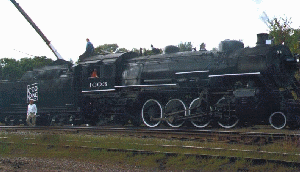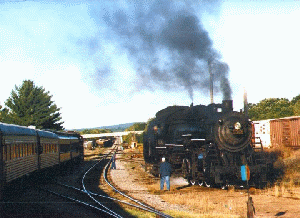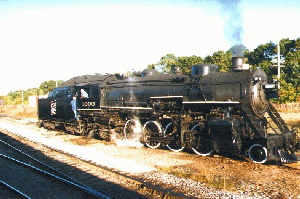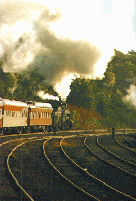|
Soo Line Locomotive 1003
In March of 1913 American Locomotive Company (ALCO) at its Schenectady Works
completed order number S-934 consisting of ten 2-8-2 Mikado locomotives for the
Minneapolis, St. Paul & Sault Ste. Marie Railroad. These locomotives, with
builders numbers 52824 through 52833, included engine 1003 with builder number
52826.
Engine 1003 had 28" X 30" cylinders, 63-inch driver wheels, and originally
came with a tender having a capacity of 7,500 gallons of water and 12 tons of coal.
Total weight was 433,500 pounds. The boiler carried 170 pounds per square inch pressure
with 258 2" flues and 34 5-3/8" flues. A Schmidt superheater was included in the
original engine. The grate area of the fire box was 63.26 square feet. The combined
heating surface was 5,163 square feet. This combination produced a starting tractive
effort of 53,940 pounds.
The brake system was a Westinghouse 8-1/2 inch LH cross-compound air pump.
Valve gear is Walschaert.
An oil headlamp was on the locomotive as originally built. These locomotives had
their headlights converted to electricity in late 1913 and 1914.
Some of the major changes made to this locomotive were:
- The classification lamps were changed from oil to electric in 1920.
- Power reverse gear was installed in July 1925, with an auxiliary air reservoir being
added in 1947.
- During the 1930s footboards were applied to the rear of the tenders. The 1003 was
carrying tender 1008 at that time and the addition was made at Superior on December 21,
1933.
- A major facelift occurred in November 1941. A larger sandbox was applied, the big
wooden pilot on the front of the engine was replaced with a tubular steel pilot, and the
wood and canvas cab roog was replaced with an enlarged steel cab. At this same time,
the feedwater heater was replaced and the superheater upgraded with an Elasco Type A.
- Also in 1941, a Standard Type MP Stoker was added with the newly built (by the Soo Line)
tender 1054. This new tender had a capacity of 12,000 gallons of water and 17-1/2 tons of
coal. After the 1941 improvements, the engine weight increased to 513,600 pounds.
- Tender 1054 remained behind the 1003 until 1949, when it was replaced by the 4003, a
18.000 gallon, 17-1/2 ton capacity tender. Some time prior to retiring, the 4003 was
replaced by the 4002 of similar design.
|
Engine 1003 could operate over all of the Soo Line except for a few of the branches which
had very light rail. The 1003 operated regularly through the Chippewa Falls area while in regular
service. These engines were considered versatile and efficient.
The engine was originally purchased in 1913 for a cost of $25,654.63. Scrap prices obtained
from engines of this size in the late 1950s was about $5,000.00.
The end of steam sounded on the Soo Line in the early 1950s. The 1003 was one of about
ten engines that were held in reserve from the scrap heap and maintained in standby condition
in the event that there would not be enough diesel power after the Korean War. Trackside
water tanks and coal sheds were also retained during this period on the Shoreham (Twin Cities)
to Sault Ste. Marie line so that in the event business levels increased, steam could take over
on this district and release diesels to other areas.
In 1959, it was decided to retire all steam facilities. Engine 1003 was retired in August 1959
and presented to the City of Superior on December 30th where it remained on static display.
It is estimated that it logged approximately 1.75 million miles while in active service.
Restoration
In the 1980s, a group of railroad enthusiasts in Superior attempted to begin a restoration
of the engine, however, the effort fell through.
In 1994, the Wisconsin Railway Preservation Trust approached the City of Superior and
purchased the engine and late in 1994 it was moved into a warehouse in Superior, owned by
Fleming Foods. Restoration was completed at this location in November 1996.
This excursion represents one of the first trips of a revenue excursion by the 1003.
As you travel today, ponder a few of these facts:
- The engine is 84 feet long with tender.
- It is 16 feet tall.
- Although we will be restricted to slower track speeds today, it can move at 60 mph while
pulling 3,000 tons.
- Each of its two pistons generates 1,500 horsepower.
- The engines main drive wheels are nearly 5-1/2 feet in diamater and turn at 300 rpms at
top speed.
- It uses approximately 100 gallons of water and 100 pounds of coal for each mile it travels.
|






